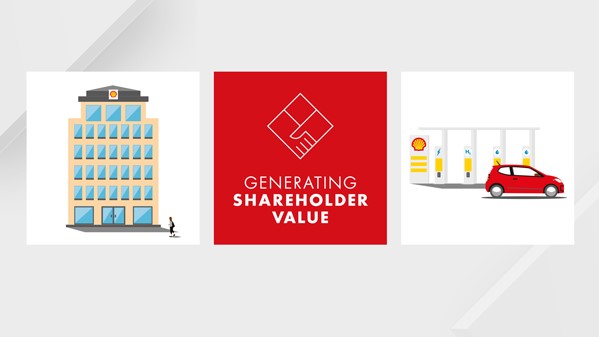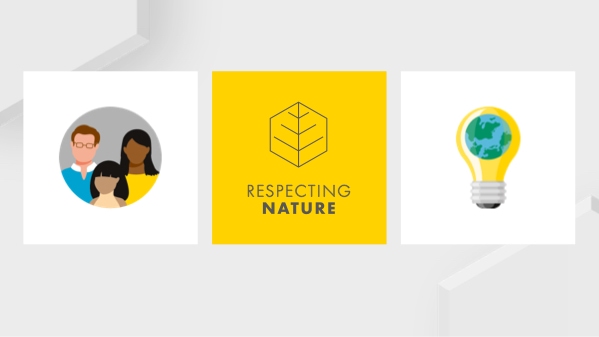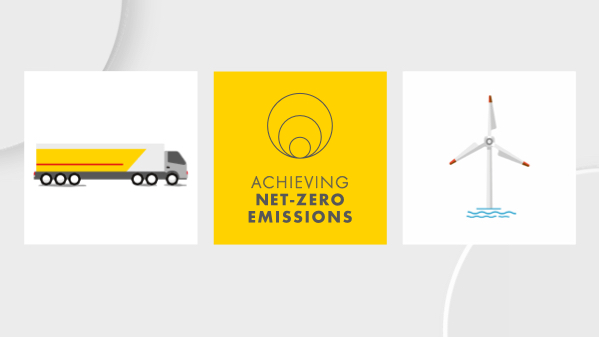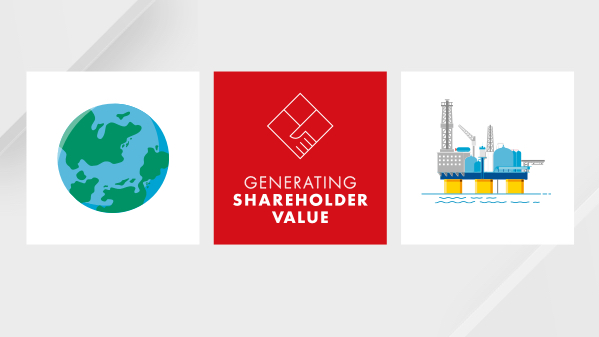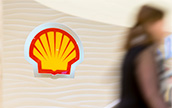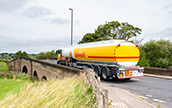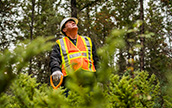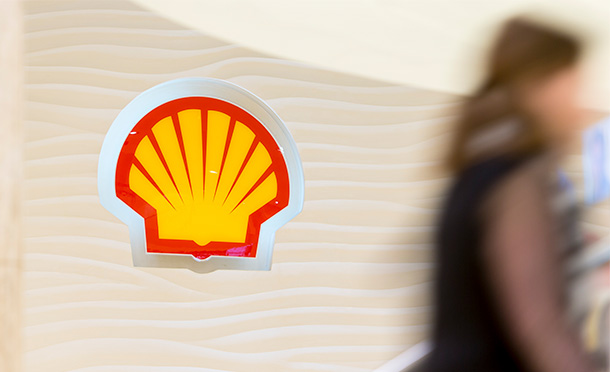Environment
In 2021, as part of our Powering Progress strategy, we launched our Respecting Nature goal, which sets out our environmental ambitions around biodiversity, water, circular economy and waste, and air quality. Our Respecting Nature commitments step up our approach to managing the impacts of our operations on the environment. They also aim to extend our approach with our supply chain, for example, with commitments around plastics and circular economy.
We adopted short-term goals and also set environmental ambitions for 2030 and later. We have been working to embed these new requirements into our systems and processes. Accountability for delivery of the Respecting Nature goal lies with our Executive Committee. We have restructured and resourced our organisation to add specialists on biodiversity and circularity and are building capability with the help of external partners.
We have included our new commitments in our performance management and reporting systems and are defining the baselines for each of the commitments and setting 2022 targets across our businesses. We are working with external environmental partners to develop new approaches that aim to show the extent of the progress we are making towards our environmental goals.
We will continue to seek opportunities to go further. Our environmental ambitions will be underpinned by collaboration with our supply chains and transparent reporting.
Environmental standards
Shell’s global environmental standards as set in our HSSE & SP Control Framework cover our environmental performance. They include details of how to manage emissions of greenhouse gases (GHG), consume energy more efficiently, reduce gas flaring and control air quality, prevent spills and leaks of hazardous materials, use less fresh water and conserve biodiversity. We seek to apply our global environmental standards wherever we operate. When planning new major projects, we conduct detailed environmental, social and health impact assessments. We help inform our approach by drawing on external standards and guidelines, such as those developed by the World Bank and the International Finance Corporation.
The Shell HSSE & SP Standards require that we certify our major installations against an internationally recognised independent environmental management system standard if they have significant environmental risks. Major installations are crude oil and natural gas terminals, gas plants, manned offshore and onshore production platforms or flow stations, floating production and storage vessels, refineries, chemicals manufacturing facilities, mines or upgraders. For the purpose of this Report, we did not count each major installation in Upstream and Integrated Gas separately. They were aggregated into their respective operating unit or operating company, such as Shell Upstream UK or Nederlandse Aardolie Maatschappij (NAM), in line with the scope of their certifications. At the end of 2021, 98% of major installations within that scope and operated by Shell were certified against the ISO 14001:2015 Environmental Management System or were in compliance with equivalent environmental frameworks required by local regulations. At the end of 2021, there was one operating unit without active certification because of late changes with key auditing contractors and the impact of COVID-19. Actions have been taken to have their certification renewed in 2022. In addition, many installations that are not classified major, such as lubricant plants or Supply terminals, are also certified against ISO 14001 but are not included in the data above. The total also excludes major installations for which divestments were completed in 2021 or are expected to be completed in 2022.
See also “Control Framework” and “Climate change and energy transition” for more information on how we manage our GHG emissions.
Biodiversity
We have adopted an ambition to have a positive impact on biodiversity. This involves three new commitments:
- From 2021, our new projects in areas rich in biodiversity – critical habitats – will have a net-positive impact on biodiversity.
- From 2021, our nature-based solutions projects, which protect, transform or restore land, will have a net-positive impact on biodiversity.
- From 2022, we will replant forests, achieving net-zero deforestation from new activities, while maintaining biodiversity and conservation value.
We aim to minimise the impact of our projects on biodiversity and ecosystems by applying the mitigation hierarchy. This is a decision-making framework that involves a sequence of four key actions: avoid, minimise, restore and offset. We assess the potential impact of projects on biodiversity as part of our Impact Assessment process. In 2003, we committed not to explore for, or develop, oil and gas resources in natural and mixed World Heritage Sites.
If we decide to go ahead with a project that is in a critical habitat, we develop a biodiversity action plan. This sets out what we should do to follow the mitigation hierarchy. If there is an impact on biodiversity, the plan outlines the action required to achieve a net-positive outcome for biodiversity. For example, in Australia, the Shell-operated QGC natural gas project manages the 10,000-hectare Valkyrie property as part of its strategy to offset impacts on biodiversity. In 2021, QGC completed the final steps to secure further hectares of habitat for three threatened species: koala, south-eastern long-eared bat and greater glider.
Circular economy and waste
We are working to reduce waste, improve our waste management processes and apply the principles of a circular economy, where materials are recycled and reused, across our businesses and supply chains. Our ambition is to use resources and materials efficiently and to increase reuse and recycling.
We are aiming for zero waste by reducing waste generated and increasing reuse and recycling in our businesses and supply chains. In 2021, we conducted pilot assessments to develop and test a methodology that we could use across a number of businesses in 2022 to gather options to set goals for 2023+ relating to circular economy and waste management.
Some of our sites and businesses are already starting to take a more circular approach. For example, our Mobility business has made the commitment that all Shell-owned service stations will reduce, reuse and repurpose waste by 2025. By 2025, we also aim to remove unnecessary single-use plastic, such as bags, straws and cutlery from our service station shops. We will make it easier for customers to recycle and are looking for ways to repurpose plastic waste.
We have also set commitments to work with our suppliers and contractors to help end plastic waste in the environment:
- By 2030, we will increase the amount of recycled plastic in our packaging to 30% and ensure that the packaging we use for our products is reusable or recyclable.
- We will increase the amount of recycled materials used to make our products, starting with plastics. Our ambition is to use 1 million tonnes of plastic waste a year in our global chemical plants by 2025.
Water
Managing our impacts on water and ensuring the availability of fresh water for our operations is a growing challenge in some parts of the world. Increasing demand for water resources, growing stakeholder expectations and concerns, and water-related legislation may reduce our access to water.
We manage water use carefully, and tailor our use of fresh water to local conditions and requirements. We sometimes use alternatives to fresh water in our operations. These include water that has been recycled from our operations, processed sewage water and desalinated water. We require that all Shell facilities and projects are assessed to see what risks they might pose to water availability. In places where water is scarce, we develop water-management action plans for using less fresh water, increasing water recycling and closely monitoring water use.
In 2021, we set a measurable target for fresh-water use: we will reduce the amount of fresh water consumed in our facilities. This will start with reducing our consumption of fresh water by 15% by 2025 compared with 2018 levels in water-stressed areas, which are places where there is high pressure on fresh-water resources.
At the end of 2021, four of our major facilities were in areas where there is a high level of water stress, based on analysis using references such as the World Resources Institute’s Aqueduct Water Risk Atlas and information specific to the local environment. These four facilities are the Pearl GTL (gas-to-liquids) plant in Qatar, the Shell Energy and Chemicals Park in Singapore, the Shell Jurong Island chemical plant, also in Singapore, and the Tabangao Import Terminal in the Philippines. In 2021, these four facilities consumed 22 million cubic metres of fresh water, compared with their baseline of 25 million cubic metres in 2018.
We have also stated that, by the end of 2022, we will have assessed options for further goals related to reducing our use of fresh water.
In 2021, we conducted a pilot assessment of circular approaches towards fresh-water consumption. This helped us to develop a methodology that will be used to assess businesses’ performance in 2022. We believe that this will help deepen our understanding of how to improve water efficiency and help us set further goals by the end of 2022. The assessments involve desktop analysis and detailed site evaluations conducted with external organisations.
In 2021, our overall intake of fresh water decreased to 166 million cubic metres, compared with 171 million cubic metres in 2020 mainly driven by the shutdown of the Shell Convent Refinery (USA) in December 2020.
Around 90% of our intake of fresh water was used for manufacturing oil products and chemicals, with the rest mainly used for oil and gas production. Around 35% of our fresh-water intake was from public utilities, such as municipal water supplies. The rest was taken from surface water such as rivers and lakes (around 55%) and groundwater (around 10%).
Additional inform<<<ation on our 2021 environmental performance is expected to be published in the Shell Sustainability Report in April 2022.
Air quality
We are helping to improve air quality by reducing emissions from our operations and providing cleaner ways to power transport and industry. We take steps to manage airborne pollutants in our oil and gas production and processing, such as nitrogen oxides, sulphur oxides and volatile organic compounds.
See our website shell.com for more information about our approach to biodiversity, circular economy and plastic waste, and water.
Respecting Nature
Shell’s new commitments from 2021
Biodiversity
- Our new projects in areas rich in biodiversity – critical habitats – will have a net positive impact on biodiversity, starting implementation in 2021.
- Our nature-based solutions projects, which protect, transform or restore land, will have a net positive impact on biodiversity, starting implementation in 2021.
- We will replant forests, achieving net-zero deforestation from new activities, while maintaining biodiversity and conservation value, starting implementation in 2022.
Circular economy and waste
We are aiming for zero waste by reducing waste generated and increasing reuse and recycling in our businesses and supply chains. We will set goals for waste reduction, reuse and recycling by the end of 2022.
We will work with our suppliers and contractors to help end plastic waste in the environment:
- By 2030, we will increase the amount of recycled plastic in our packaging to 30% and ensure that the packaging we use for our products is reusable or recyclable.
- We will increase the amount of recycled materials used to make our products, starting with plastics. Our ambition is to use one million tonnes of plastic waste a year in our global chemicals plants by 2025.
Water
- We will reduce the amount of fresh water consumed in our facilities, starting by reducing fresh-water consumption by 15% by 2025 compared with 2018 levels in areas where there is high pressure on fresh-water resources.
- 25 million cubic metres of fresh water were consumed by our facilities in highly water-stressed areas in 2018.
- We will also assess options for further reduction goals by the end of 2022.
Air quality
We are helping to improve air quality by reducing emissions from our operations and providing cleaner ways to power transport and industry.
Collaboration and reporting
- Supply chain: We will include requirements in our purchasing policies to reflect our environmental framework, and take the energy efficiency, material efficiency and sustainability of products into consideration in our purchases.
- External partnerships: We will ensure external partnerships inform key areas of development and delivery of our ambitions.
- External reporting: We will transparently report performance in our annual Sustainability Report.
Large spills of crude oil, oil products and chemicals associated with our operations can harm the environment, and result in major clean-up costs, fines and other damages. They can also affect our licence to operate and harm our reputation.
We have requirements and procedures designed to prevent spills. We design, operate and maintain our facilities with the intention of avoiding spills. To further reduce the risk of spills, Shell has routine programmes to reduce failures and maintain the reliability of facilities and pipelines. Our business units are responsible for organising and executing spill responses in line with Shell guidelines and relevant legal and regulatory requirements. Our offshore installations have spill response plans for when an incident occurs. These plans set out response strategies and techniques, available equipment, and trained personnel and contracts. We can engage specialist contracted services for oil spill response, including vessels, aircraft or other equipment and resources, if required, for large spills. We conduct regular exercises that seek to ensure these plans remain effective and fit for purpose.
We have further developed our ability to respond to spills to water. We have a worldwide network of trained staff to help with this. We also have a global oil spill expertise centre, which tests local capability and maintains our ability to respond to a significant spill into a marine environment.
We are involved in several industry consortia formed to improve well-containment capabilities. Shell Offshore Response Company LLC is a founding member of the Marine Well Containment Company, a non-profit industry consortium providing a well-containment response system for the Gulf of Mexico. Shell Response Limited was a founding member of the Subsea Well Response Project, an industry co-operative effort to enhance global well-containment capabilities, which has since become Oil Spill Response Limited, an industry consortium.
We maintain site-specific emergency response plans in case there is an onshore spill. Like the offshore response plans, these are designed to meet Shell guidelines and relevant local legal and regulatory requirements. The onshore response plans also provide for the initial assessment of incidents and the mobilisation of resources to manage them. In the event of spills on land, businesses are supported by our global Soil & Groundwater team which reviews and implements appropriate remedies. The Soil & Groundwater team is engaged throughout the life cycle of our assets. For example, during acquisition and divestment of assets, the team conducts due diligence to identify land contamination liabilities. Through research and development initiatives, the team collaborates with regulators in developing, modifying, and applying sustainable remediation techniques.
Spills still occur for reasons such as operational failure, accidents or unusual corrosion. In 2021, there were 42 operational spills of more than 100 kilograms compared with 70 in 2020. The weight of operational spills of oil and oil products in 2021 was 0.05 thousand tonnes, compared with 0.4 thousand tonnes in 2020.
Spills in Nigeria
In the Niger Delta, over the last 11 years, the total number of operational hydrocarbon spills and the volume of oil spilled from them into the environment have been significantly reduced.
Most oil spills in the Niger Delta region continue to be caused by crude oil theft, the sabotage of oil and gas production facilities, and illegal oil refining, including the distribution of illegally refined products.
In 2021, the Shell Petroleum Development Company of Nigeria Limited (SPDC) reported 10 operational spill incidents of more than 100 kilograms of crude oil, fewer than the 12 reported in 2020. The volume of around 0.03 thousand tonnes remained on the same level.
SPDC has an ongoing work programme to appraise, maintain and replace key sections of pipelines and flow lines, in order to reduce the number of operational spills. Over the last 11 years, around 1,410 kilometres of pipelines and flow lines have been replaced. This work is organised through a pipeline and flow line integrity management system that proactively addresses pipeline integrity. It installs barriers where necessary, and recommends when and where pipeline sections should be replaced to prevent failures. In 2018, this integrity management system was enhanced to manage threats arising from frequent pipeline sabotage or vandalism.
Spills caused by sabotage in 2021
In 2021, more than 90% of the oil spills of more than 100 kilograms from the SPDC joint venture’s facilities were caused by the illegal activities of third parties. In 2021, the volume of crude oil spills of more than 100 kilograms caused by sabotage was around 3.3 thousand tonnes (107 incidents), compared with around 1.5 thousand tonnes (122 incidents) in 2020. We believe that the number of incidents in 2021 continued to decrease because of improved security and surveillance. The doubling of the volume was mainly because of one incident which alone accounted for around 2.3 thousand tonnes of crude oil which was contained and could be recovered.
SPDC continues to undertake initiatives to prevent and reduce spills caused by theft from or sabotage of its facilities in the Niger Delta. In 2021, SPDC continued on-ground surveillance of its areas of operation, including its pipeline network, to mitigate third-party interference and ensure that spills are detected and responded to as quickly as possible.
There are daily overflights of the most vulnerable segments of the pipeline network to identify any new spills or illegal activity. SPDC has introduced anti-theft protection mechanisms for key infrastructure such as wellheads and manifolds. The programme to protect wellheads with steel cages continues to help deter theft.
By the end of 2021, a total of 283 cages had been installed, including 62 that had been upgraded with CCTV. This compared with a total of 364 installed cages at the end of 2020. This year-on-year reduction was because of the 2021 divestment of the OML-17 licence. In 2021, 29 breaches were successful out of 1,700 registered attempts.
Faster response and remediation
Irrespective of the cause, SPDC works to clean up and remediate areas affected by spills originating from its facilities. In 2021, the time that SPDC needed to complete the recovery of free-phase oil – oil that forms a separate layer and is not mixed with water or soil – remained at around one week compared to 2020. This is the average time it takes to safely access a damaged site to start joint investigation visits with regulators, affected communities, and in some cases with NGOs, to clean up oil not mixed with water or soil.
Clean-up activities include bio-remediation which stimulates micro-organisms that naturally break down and use carbon-rich oil as a source of food and energy, effectively removing it. Once clean-up and remediation operations are completed, the work is inspected and, if satisfactory, approved and certified by the Nigerian regulators. With operational spills, SPDC also pays compensation to affected people and communities.
SPDC has been working with the International Union for Conservation of Nature (IUCN) since 2012 to enhance remediation techniques and protect biodiversity at sites affected by oil spills in SPDC’s areas of operation in the Niger Delta. Based on this collaboration, SPDC has launched further initiatives to help strengthen its remediation and restoration efforts. In 2021, SPDC, IUCN, the Nigerian Conservation Foundation, and Wetlands International worked together on the Niger Delta Biodiversity Technical Advisory Group, which continues to monitor biodiversity recovery at remediated sites.
SPDC also works with a range of stakeholders in the Niger Delta to build greater trust in spill response and clean-up processes. Local communities participate in remediation work for operational spills. The restrictions of COVID-19 meant there were fewer opportunities to collaborate, but the engagement and partnership with communities continued. Various NGOs have sometimes gone on joint investigation visits with SPDC, government regulators, and members of affected communities to establish the cause and volume of oil spills.
SPDC has implemented programmes to raise awareness of and counter the negative effects of crude oil theft and illegal oil refining. Examples include community-based pipeline surveillance, and promoting alternative livelihoods through Shell’s flagship youth entrepreneurship programme, Shell LiveWIRE.
Bodo clean-up process
In 2015, SPDC, on behalf of the SPDC joint venture and the Bodo community, signed a memorandum of understanding (MOU) granting SPDC access to begin cleaning up areas affected by two operational spills that occurred in 2008. The MOU also provided for the selection of two international contractors to conduct the clean-up under the oversight of an independent project director. The clean-up project was delayed in 2016 and for most of 2017 because of access challenges from the community. Engagement with the Bodo community and other stakeholders began in September 2015 and was managed by the Bodo Mediation Initiative.
After two years of engagement, in September 2017, it was possible to start the first phase of clean-up and remediation activities. The clean-up consists of three phases:
- removal of oil from shoreline surfaces and mud flat beds;
- remediation of soil and sediments; and
- planting mangroves and monitoring.
The first phase was completed in August 2018. The contract procurement process for phase two was completed in 2019. Remediation activities in the field started in November 2019. During 2020, work had to be put on hold because of COVID-19 restrictions. By November 2020, controls were in place to mitigate impacts from COVID-19 for the workers on site and the remediation work resumed.
In 2021, the remediation of the soil and sediments at the Bodo project site continued. By the end of 2021, remediation work was completed on more than 60% of around 1,000 hectares that have been designated for clean-up. Almost 2,000 community workers have been trained and engaged in the clean-up. Remediation is expected to be completed by the end of the second quarter of 2023.
The planting of mangrove seedlings (phase 3) started in 2021. Around two million mangrove seedlings need to be planted and survive to 2025 to fulfil the project’s goal. By the end of 2021, about 300,000 seedlings had been planted.
Ogoniland: commitment to the United Nations Environment Programme
SPDC remains committed to the implementation of the 2011 United Nations Environment Programme (UNEP) Report on Ogoniland which assessed contamination from oil operations in the region and recommended actions to clean it up. Over the last 10 years, SPDC has acted on all and completed most of the UNEP recommendations that were specifically addressed to it as the operator of the joint venture.
The clean-up efforts are led by the Hydrocarbon Pollution and Remediation Project (HYPREP), an agency established by the federal government. In 2018, HYPREP awarded contracts for the first set of remediation projects. In 2019, 21 contractors started operations on 21 lots which add up to 12 of the 67 polluted sites recorded in the UNEP report. Of those 67 sites, two are waste sites without hydrocarbon pollution. In January 2020, HYPREP awarded a further 29 contracts for remediation on 29 lots covering eight polluted sites. The contractors began remediation activities in the fourth quarter of 2020. In 2021, remediation work was completed on nine sites which have been certified by the National Oil Spill Detection and Response Agency (NOSDRA), the Nigerian government agency responsible for monitoring of and responding to oil spills. Remediation continues on 11 sites. Although remediation works continue to make progress, challenges remain. These include re-pollution, lack of contractor funding, land disputes, environmental issues such as flooding caused by excessive rainfall, and security issues in Ogoniland.
The UNEP report recommended creating an Ogoni Trust Fund (OTF) with $1 billion capital, to be co-funded by the Nigerian government, the SPDC joint venture and other operators in the area. The SPDC joint venture remains fully committed to contributing $900 million to the fund as its share over five years. SPDC joint-venture partners contributed the first instalment of $180 million for the clean-up by July 2018, and released the second instalment of $180 million in 2019. HYPREP did not request the release of any funds in 2020. In 2021, HYPREP requested the release of funds for 2020 and 2021. The SPDC joint venture partners agreed to only pay the 2021 instalment of $180 million because of a delayed use of funds by HYPREP, which only spent around $70 million of the fund. The request for the 2021 payment is being processed. Once the payment is made the total contribution by the SPDC joint venture will be $540 million.
The UNEP continues to monitor the progress of the clean-up through its observer status at HYPREP’s Governing Council and the Ogoni Trust Fund. UN agencies such as the United Nations Development Programme and the United Nations Institute for Training and Research provide services to HYPREP in the areas of livelihood programmes, training and project services.
Onshore Operating Principles
We use five aspirational operating principles which focus on safety, environmental safeguards, and engagement with nearby communities to address concerns and help develop local economies. We are working towards making all of our Shell-operated onshore projects where hydraulic fracturing is used to produce gas and oil from tight sandstone or shale, consistent with these principles.
We consider each project – from the geology to the surrounding environment and communities – and design our activities using technology and innovative approaches best suited to local conditions. We also support government regulations consistent with these principles that are designed to reduce risks to the environment and keep those living near operations safe.
We review the Onshore Operating Principles annually and update them as new technologies, challenges and regulatory requirements emerge.
Water
The availability and quality of water, local environmental conditions and regulatory requirements vary from basin to basin.
We aim to minimise water usage in our shale assets by developing a water management strategy specific to the area. Depending on local hydro-geological conditions, our shale assets typically use a combination of fresh water, brackish groundwater, produced water and waste water. We work to limit, and ideally eliminate, our use of fresh water in drilling and hydraulic fracturing operations by increasing recycling capacity and using municipal water.
Chemical additives are needed in hydraulic fracturing fluid to carry sand, reduce friction and prevent the growth of bacteria. Hydraulic fracturing involves pumping fluid that is typically 99.9% water and sand and around 0.1% chemical additives into tight sand or shale rock at high pressure. This creates threadlike fissures – typically the diameter of a human hair – in the rock, making space through which the hydrocarbons can flow more easily.
Greenhouse gas
Shell’s shale assets implement greenhouse gas management plans including robust leak detection and repair programmes using the latest technologies, such as infrared cameras and drones. We also seek to minimise routine gas flaring at shale assets.
Shell sold its stake in the Permian Basin, USA, with effect from December 1, 2021. Between the beginning of 2017 and the end of 2021, we reduced our greenhouse gas and methane intensity of the Permian assets by around 80%. We also reduced flaring by more than 80%. At the same time, production increased at the Shell-operated assets by nearly 120%.
Operational footprint
Our Shales assets use technology, local knowledge and management strategies to minimise potential impacts such as high traffic volumes, noise, and effects on supplies of drinking water.
Communities
We build relationships and engage with a broad range of stakeholders across the entire project life cycle. Our stakeholders include residents, local communities – including indigenous populations – government officials, NGOs, civil-society groups, academia and industry. We focus our engagement on understanding local social and economic conditions and proactively identifying and responding to those concerns.
See our website shell.com for more information on our Onshore Operating Principles.
Overall, we believe it is relatively unlikely that hydraulic fracturing or well operations for disposing of produced water will induce seismicity that is felt on the surface. We would also expect any such impact to be limited to a relatively small area. The geology of some places, though, does increase the risk of inducing seismicity that can be felt on the surface. Shell assesses the risk profile of each basin before entering and manages operations accordingly, often beyond regulatory requirements. We assess the subsurface formation and surface environment around our operations and have developed appropriate mitigation plans to follow if needed.
See our website shell.com for more information about our induced seismicity management practices, such as the “Onshore Operating Principles in Action: Induced Seismicity Fact Sheet”.
For information on the Groningen onshore gas field in the Netherlands, see “Upstream”.
We are subject to a variety of environmental laws, regulations and reporting requirements in the countries where we operate. Infringing any of these laws, regulations and requirements could harm our reputation and ability to do business, and result in significant costs, including clean-up costs, fines, sanctions and third-party claims.
Ongoing operating expenses include the costs of preventing unauthorised discharges into the air and water, and the safe disposal and handling of waste.
We place a premium on developing effective technologies that are also safe for the environment. But when operating at the forefront of technology, there is always the possibility that a new technology has environmental impacts that were not assessed, foreseen or determined to be harmful when originally implemented. While we believe we take reasonable precautions to limit these risks, we could be subject to additional remedial, environmental and litigation costs as a result of unknown and unforeseen impacts of operations on the environment. Although these costs have so far not been material to us, no assurance can be given that this will always be the case.

